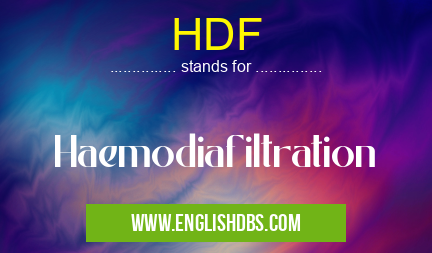What does HDF mean in THERAPY
HDF (Haemodiafiltration) is a type of renal replacement therapy (RRT) used to treat patients with end-stage renal disease (ESRD). It combines the principles of hemodialysis and hemofiltration to provide a more effective and gentle method of blood purification.

HDF meaning in Therapy in Medical
HDF mostly used in an acronym Therapy in Category Medical that means Haemodiafiltration
Shorthand: HDF,
Full Form: Haemodiafiltration
For more information of "Haemodiafiltration", see the section below.
HDF Meaning
HDF stands for Haemodiafiltration. It is a hybrid therapy that utilizes:
- Hemodialysis: Diffusion across a semipermeable membrane to remove waste products and excess fluid from the blood.
- Hemofiltration: Convection through a membrane to remove larger molecules and toxins.
HDF Process
HDF involves passing the patient's blood through a dialyzer and a hemofilter. The dialyzer removes waste products and fluid, while the hemofilter removes larger molecules and toxins. The process is controlled by a machine that monitors the patient's blood pressure, fluid balance, and electrolyte levels.
Advantages of HDF
HDF offers several advantages compared to traditional hemodialysis:
- More efficient removal of waste products: HDF removes larger molecules and toxins that conventional hemodialysis cannot.
- Gently clears fluids: Hemofiltration uses convection to remove excess fluid, which is less stressful on the heart and blood vessels.
- Improved blood pressure control: HDF helps regulate blood pressure and reduce the risk of hypertension.
- Preserves residual renal function: HDF allows some of the patient's own kidneys to continue functioning.
Essential Questions and Answers on Haemodiafiltration in "MEDICAL»THERAPY"
What is Haemodiafiltration (HDF)?
Haemodiafiltration (HDF) is a renal replacement therapy (RRT) used to remove waste products and excess fluid from the bloodstream when the kidneys are not functioning properly. It combines the principles of haemodialysis and haemofiltration.
How does HDF work?
HDF utilizes a semipermeable membrane to separate waste products and excess fluid from the blood. As the blood passes through the membrane, water and solutes are filtered out, while larger molecules such as proteins are retained.
What are the advantages of HDF?
HDF offers several advantages over traditional haemodialysis:
- Removes larger molecules and uremic toxins that may not be effectively cleared by dialysis alone.
- Provides better fluid management, reducing the risk of fluid overload.
- May preserve residual renal function by allowing for ultrafiltration and convection.
Who is a candidate for HDF?
HDF is suitable for patients with advanced kidney disease, particularly those who:
- Have difficulty controlling fluid balance.
- Are intolerant to conventional haemodialysis.
- Have residual renal function.
- Have specific medical conditions, such as sepsis or hemodynamic instability.
Are there any risks or side effects associated with HDF?
As with any medical procedure, there are potential risks and side effects associated with HDF, including:
- Hypotension (low blood pressure).
- Electrolyte and acid-base imbalances.
- Blood clotting in the dialyzer.
- Infection at the vascular access site.
Final Words: HDF is an advanced RRT technique that provides effective blood purification for patients with ESRD. It combines the benefits of hemodialysis and hemofiltration, resulting in improved patient outcomes and a better quality of life. As a valuable treatment option, HDF continues to play a significant role in the management of end-stage renal disease.
